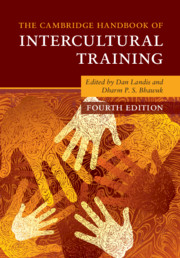Book contents
- The Cambridge Handbook of Intercultural Training
- Reviews
- The Cambridge Handbook of Intercultural Training
- Copyright page
- Dedication
- Frontispiece
- Contents
- Figures
- Tables
- Editors and Contributors
- Foreword
- Preface
- 1 Introduction and Theoretical Framework
- Part I Theoretical Foundations of Intercultural Training
- Part II Practice of Intercultural Training
- 10 International Initiatives in K–12 and Higher Education
- 11 The Triad Training Model in Counseling, Cultural Diversity, and Intercultural Training
- 12 Multicultural Counseling Training and Intercultural Training
- 13 Training for Cross-Cultural Competence in the United States Military
- 14 Developing Intercultural Competency Training in Global Organizations
- Part III Indigenous Psychology and Intercultural Training
- Part IV New Interdisciplinary Approaches to Intercultural Training
- Part V Summing Up
- Index
- References
10 - International Initiatives in K–12 and Higher Education
Learning from and Moving Beyond Disciplinary History
from Part II - Practice of Intercultural Training
Published online by Cambridge University Press: 18 September 2020
- The Cambridge Handbook of Intercultural Training
- Reviews
- The Cambridge Handbook of Intercultural Training
- Copyright page
- Dedication
- Frontispiece
- Contents
- Figures
- Tables
- Editors and Contributors
- Foreword
- Preface
- 1 Introduction and Theoretical Framework
- Part I Theoretical Foundations of Intercultural Training
- Part II Practice of Intercultural Training
- 10 International Initiatives in K–12 and Higher Education
- 11 The Triad Training Model in Counseling, Cultural Diversity, and Intercultural Training
- 12 Multicultural Counseling Training and Intercultural Training
- 13 Training for Cross-Cultural Competence in the United States Military
- 14 Developing Intercultural Competency Training in Global Organizations
- Part III Indigenous Psychology and Intercultural Training
- Part IV New Interdisciplinary Approaches to Intercultural Training
- Part V Summing Up
- Index
- References
Summary
This chapter begins by tracing the development of initiatives in intercultural and multicultural education that have dominated the paradigm of K–12 education and teacher preparation for more than sixty years before moving to more recent attempts to integrate international or global perspectives into the education of all. Throughout the chapter, key concepts from the fields of cross-cultural communication and intercultural training, as well as the work of influential intercultural researchers and practitioners, are analyzed particularly emphasizing how they have influenced the field of education. Recent and promising international education initiatives and practices, organizations that promote comprehensive curricular frameworks and/or policy initiatives, and outcomes of recent studies that assess their impact in K–12 as well as higher education are presented. Finally, we argue for a new perspective on terminology, so rather than continuing to work myopically within independent disciplines, we begin to look across our efforts to understand other cultures under the umbrella term “education that is cultural,” or ETIC.
- Type
- Chapter
- Information
- The Cambridge Handbook of Intercultural Training , pp. 357 - 376Publisher: Cambridge University PressPrint publication year: 2020



